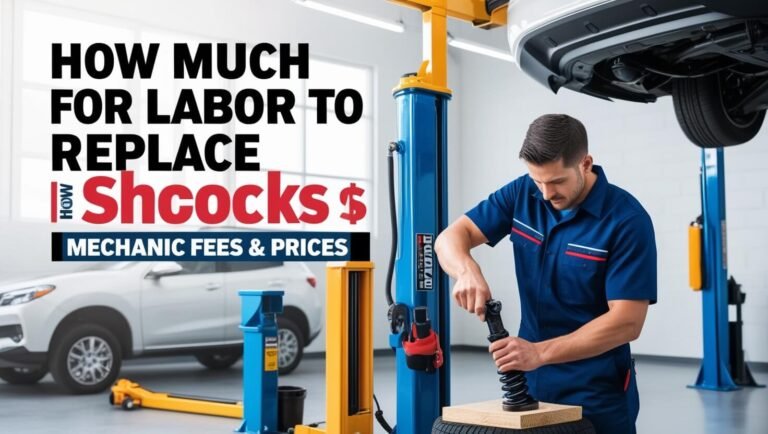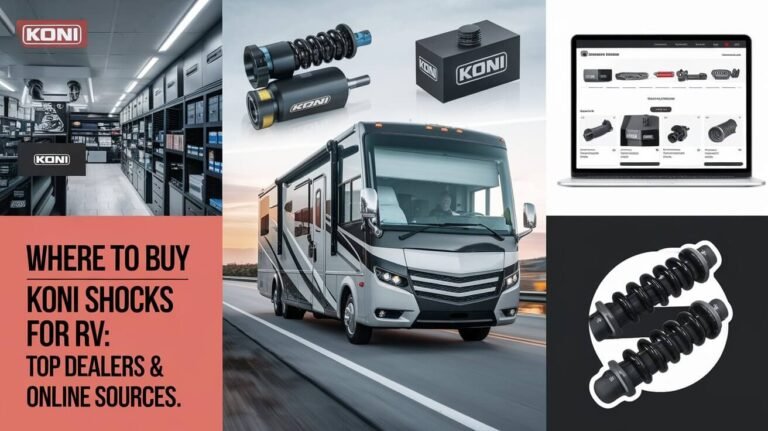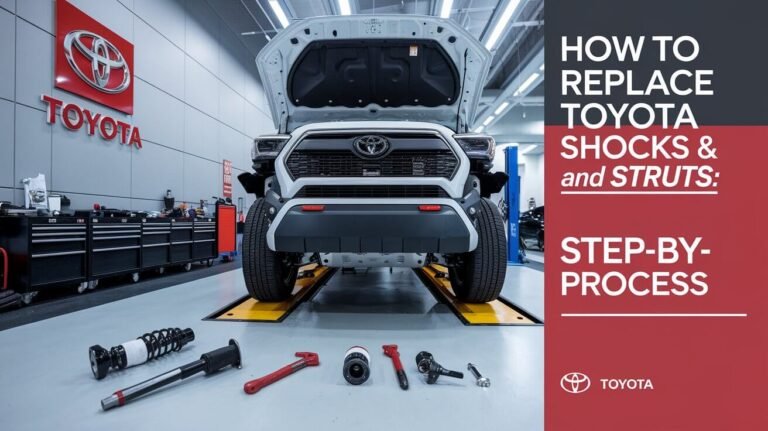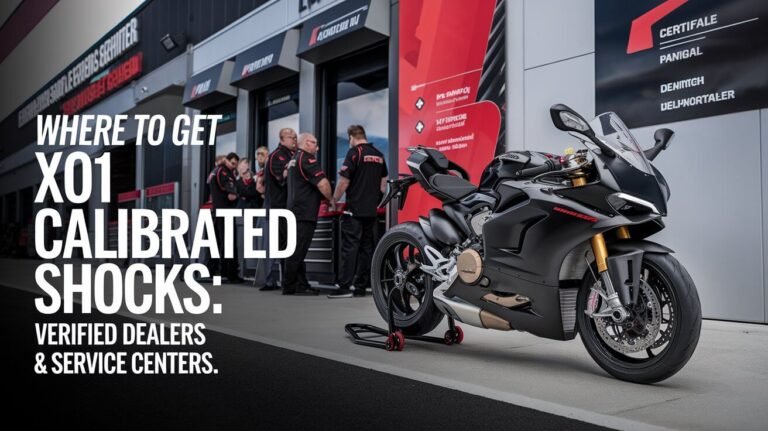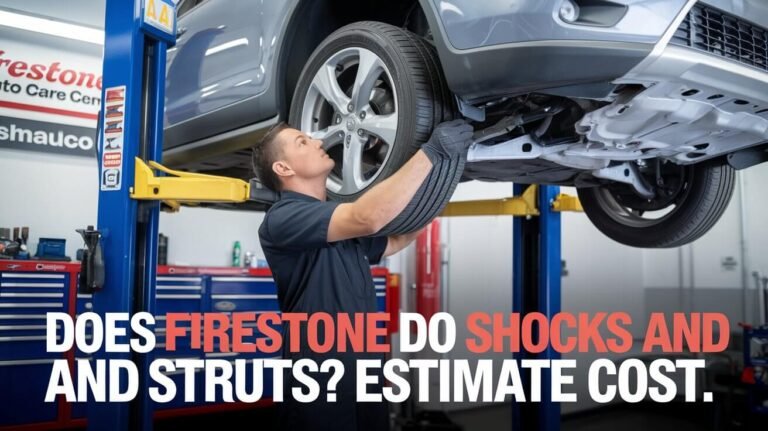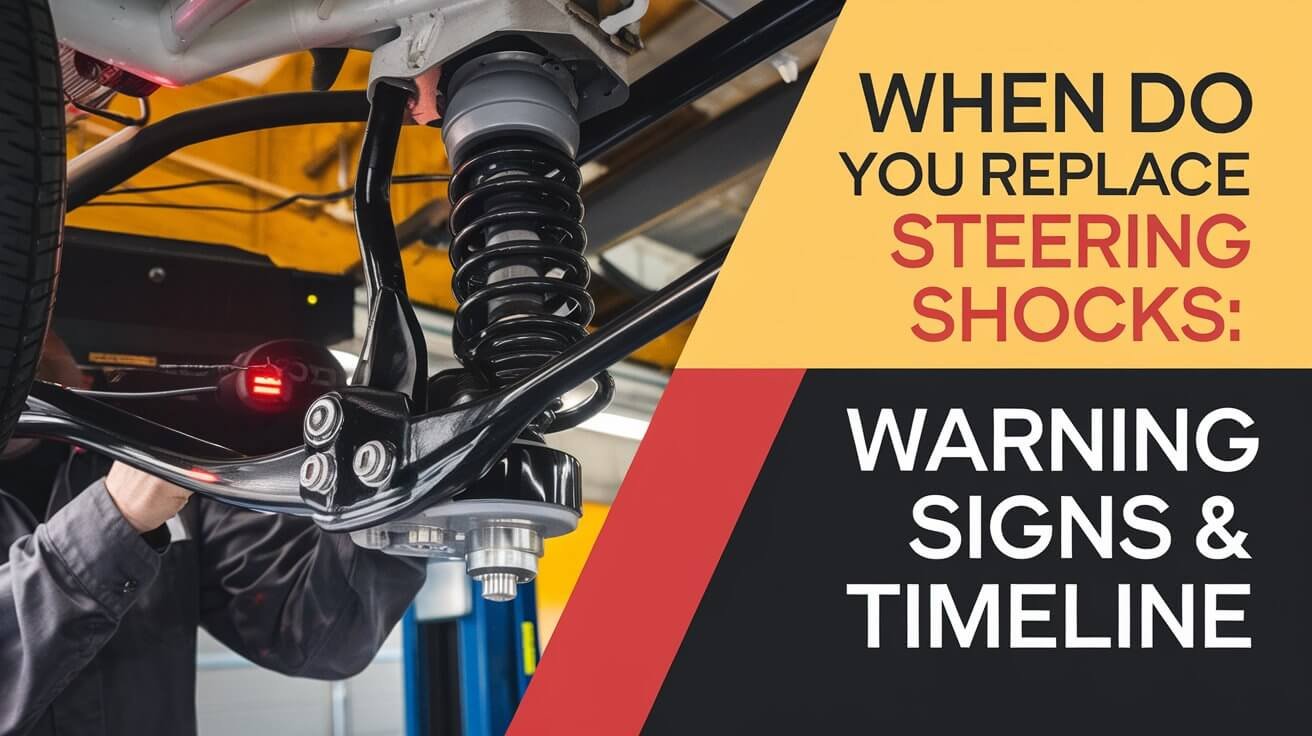
As drivers, we often overlook the importance of our vehicle’s steering shocks until a problem arises. These unsung heroes of the suspension system play a crucial role. They ensure our rides remain stable, responsive, and comfortable. But when is the right time to replace these essential components? Let’s explore the ins and outs of steering shock maintenance and find the answer to this pressing question.
Basic Functions of Steering Shock Absorbers
Steering shock absorbers, also known as steering dampers, are key to a vehicle’s stability and control. They help us drive confidently and precisely. These components are essential for a smooth ride.
Role in Vehicle Stability
When we turn or curve, the steering damper keeps our vehicle stable. It stops the wheels from shaking too much. This is crucial for cars with big tires, which can handle poorly.
The damper smooths out the steering wheel’s movement. This ensures our car handles well, even when driving is tough.
Protection Against Road Vibrations
The steering damper acts as a shock absorber. It takes in the road’s shocks and vibrations. This makes driving more comfortable, even on bumpy roads.
Impact on Steering Control
A good steering damper lets us control the car’s steering better. It stops the wheels from veering off course. This is due to worn parts or uneven tires.
Having a steering damper adds stability and comfort to driving. It’s great for those who love a dynamic driving experience. Knowing how these components work helps us value their importance in our daily drives.
Different Types of Steering Dampers
Understanding the various types of steering dampers is key to keeping your vehicle’s steering system in top shape. These dampers, also known as steering stabilizers, improve vehicle stability and make driving smoother. Let’s look at the different types available.
Standard Non-Pressurized Units
Standard non-pressurized units are the most common type of steering dampers. They are similar to the stock dampers in many vehicles. These dampers reduce the vibrations and oscillations from the steering system. While they work well in most situations, they might not offer the same level of control as pressurized dampers.
High-Pressure Gas Models
For those looking for more control and stability, high-pressure gas steering dampers are a great option. These dampers use pressurized gas to provide a consistent and responsive damping force. This helps to counteract the effects of road conditions and vehicle dynamics. Yet, the increased pressure can sometimes cause a “steering push” feeling, which may take some getting used to.
Through Rod Design Systems
The through rod design is another type of steering damper. It has a unique construction that allows for higher gas pressures without the “steering push” issue. This design ensures a smooth and responsive steering feel, making it a favorite among enthusiasts and off-road drivers.
Choosing the right steering damper for your vehicle depends on several factors. Consider your driving style, the terrain you’ll be on, and your performance goals for your suspension system. Talking to a professional in steering system repair or suspension maintenance guide can help you make the best choice. This ensures your vehicle’s steering system is working at its best.
When Do You Replace Steering Shocks
Replacing your vehicle’s steering shocks is key for a smooth ride and good handling. The life of steering shocks varies. Knowing when to replace them is important.
Noticeable steering or stability issues are a big reason to replace them. This includes a wandering steering wheel or feeling of looseness. If you see these signs, get your shocks checked and replaced if needed.
Even without obvious problems, check your shocks regularly. Off-road use or oversized tires can wear them out faster. This means you might need to replace them more often.
Shocks wear out a lot, compressing 75 million times in 50,000 miles. They can last as little as 50,000 miles. It’s best to replace them by 60,000 miles for safety and performance.
Acting early on signs of wear, you keep your vehicle safe and fun to drive. This ensures better handling and stability.
Stock vs Aftermarket Steering Stabilizers
Choosing the right steering stabilizer is crucial for your vehicle’s suspension. Stock units from the manufacturer are okay, but aftermarket options are often better. They last longer and perform better.
Performance Comparisons
Aftermarket steering stabilizers, like those from OME, offer a better driving experience. They use advanced technology for better shock absorption and stability. This is great for driving on rough terrain or making sharp turns.
Durability Factors
Upgrading to an aftermarket steering stabilizer can extend its life. OME stabilizers can last up to 100,000 miles under normal driving. But, off-road use may require more frequent replacements due to damage from rocks and other obstacles.
Cost-Benefit Analysis
When thinking about replacing your steering stabilizer, consider the cost and benefits. Aftermarket units might cost more, but their better performance and longer life make them worth it. This is true for those who often drive off-road or engage in suspension-intensive activities.
The choice between stock and aftermarket steering stabilizers depends on your driving habits and vehicle use. Knowing the performance, durability, and cost benefits helps you make a choice that suits your needs. This choice can improve your driving experience.
Effects of Oversized Tires on Steering Dampers
Upgrading to bigger and heavier tires can really affect your car’s steering dampers. The extra weight and changed steering feel put more stress on these important parts. This might mean you need stronger stabilizers or have to replace them more often to keep your car handling well.
Steering stabilizers cost between $100 and over $900, depending on the type and brand. The ones installed by the factory usually last about 50,000 miles if you drive normally. But, with bigger tires, you might need a new stabilizer to get better performance.
Dual steering stabilizers, which add more stability, cost about $951. Thru Shaft stabilizers, for consistent steering, cost between $536 and $787. Gas or gasoil hybrid stabilizers, for a sportier feel, are around $169.
Getting a new steering damper is often needed with bigger and heavier tires. If you just lift your truck but keep the same tires, you might not need a new damper. But, if your damper is old or worn out, you should replace it. It’s key for handling the extra weight and changed steering with oversized wheels.
Common Signs of Steering Damper Failure
The steering damper is a key part of your car’s steering system. It helps keep the steering smooth and responsive. But, like any part, it can wear out over time. Knowing the signs of a failing steering damper is important for keeping your car safe and fun to drive.
Physical Symptoms
A worn steering damper often causes the steering wheel to wobble or feel unstable. This makes it hard to keep the car straight while driving. You might also feel more vibrations in the steering wheel, which is uncomfortable and worrying.
Performance Indicators
Steering damper failure can also affect how your car handles. If the steering feels off or the car veers on its own, it might be a sign of a problem. Paying attention to these changes can help you catch the issue early.
Visual Inspection Points
Looking at the steering damper can show if it’s failing. Check for fluid leaks around the seals, which could mean a problem. Also, check the mounting points and the rod for any damage. These signs can tell you if it’s time for a new steering damper.
Watching for these signs, you can fix any steering damper issues before they get worse. Regular checks and replacing the damper when needed can keep your car’s steering system working well. This ensures a smooth and safe drive.
Steering Damper Lifespan Expectations
The lifespan of your vehicle’s steering damper depends on several factors. The quality and how much you use it matter a lot. Stock dampers might not last as long, but good aftermarket ones can go up to 100,000 miles or more.
But, off-road driving changes the game. Harsh terrain and bumps can wear out your damper faster. You might need to replace it every year to keep your car stable and easy to steer.
Regular checks and maintenance are crucial for your damper’s life. Look out for damage, leaks, or strange sounds. Also, make sure your wheels are aligned and your tires are balanced. This helps your damper last longer.
Knowing how long your damper should last helps keep your car safe and smooth. Regular steering shock absorber maintenance and following a good suspension maintenance guide are key. They help keep your car’s steering and suspension in top shape.
Impact of Off-Road Use on Steering Stabilizers
Off-road driving puts a lot of stress on your vehicle’s steering stabilizers. The rough terrain, rocks, and debris can damage these important parts. This often means you need to replace them more often.
Terrain Considerations
The terrain you drive on affects your steering stabilizers. Driving on rocky, uneven ground, through mud, and up steep hills wears them down fast. The tougher the terrain, the quicker they’ll need to be replaced.
Replacement Frequency
Off-road drivers might need to replace their steering stabilizers more often. The usual 80,000 km mark might not apply. Depending on how often and how hard you drive off-road, you might need to replace them every year or sooner.
| Steering Stabilizer Type | Price Range (EUR) | Durability for Off-Road Use |
|---|---|---|
| Standard Non-Pressurized | 106 – 305 | Moderate (12-24 months) |
| High-Pressure Gas Model | 415 – 695 | Good (18-36 months) |
| Thru Shaft with Reservoir | 787 | Excellent (24-48 months) |
| Dual Stabilizers with Reservoir | 951 | Optimal (24-60 months) |
Choosing durable steering stabilizers for off-road driving is smart. They can handle the rough terrain better. This means your vehicle will handle better and control will be improved, making your off-road adventures better.
Relationship Between Ball Joints and Steering Dampers
The ball joints and tie rod ends are key in your vehicle’s steering system. They let the wheels turn and the suspension move. If these parts have problems, just replacing the steering damper won’t solve it. It’s important to check and keep all steering system parts in good shape.
Checking for play in the ball joints by pulling and pushing on the tires is a good start. This can show if the ball joints need a torque check or replacement. Also, pulling and pushing the tires from the 3/9 positions can reveal play in the tie rod and drag link.
Using a long pry bar to apply upward force on the axle can show joint movement. Watching the steering shaft move while turning the tires can also help. If the play is only in the gearbox, you can tighten it with an adjusting nut. But, if the gears are too worn, you might need to replace the gearbox.
If there’s too much play causing shaking while driving, it’s best to get it fixed. Also, getting a front-end alignment can make driving smoother. Regularly checking the steering system, including the ball joints and tie rod ends, helps keep your vehicle’s steering system repair and automotive steering components in top shape.
Installation Considerations and Positioning
Installing a steering stabilizer requires careful thought about where to place it. The height adjustment is a key factor for its performance and durability.
Some aftermarket steering dampers, like those from AEV and MetalCloak, can be mounted higher. This higher position helps protect against road debris and obstacles. It can also make the stabilizer last longer. For those who often drive off-road, these higher mounting options are worth considering.
Height Adjustment Benefits
Getting the shock length right is crucial to avoid damage to suspension parts. For example, heavy snowplow installations might need ride height adjustments to prevent shock failure. Being able to adjust the mounting height ensures the stabilizer works best, lasting longer.
Protection from Road Debris
How you mount the shock absorber affects its performance. Wrong installation can cause noise when turning or hitting bumps. It’s important to replace struts with the right size to avoid coil spring rubbing on the inner fender well.
Focusing on the right installation position and height adjustment, you can enhance your steering stabilizer’s performance. This supports a smoother ride, whether on city streets or rough terrain.
Maintenance Requirements for Extended Durability
Regular maintenance is crucial for our steering shock absorbers to last long. We need to check for fluid leaks, ensure they’re mounted right, and look for any damage. If our vehicles have big tires or we drive off-road a lot, we should check them more often.
Following the recommended service schedule helps our steering dampers last longer. We should rotate our tires every 20,000 miles and grease the chassis at each oil change or every 10,000 miles. Also, checking the ball joints and steering linkage every 20,000 miles helps catch problems early.
Keeping up with these maintenance tasks, our steering shock absorbers will keep our vehicles stable and controlled. Regular care ensures our vehicles handle well, even as we drive more miles.
Most-Asked Questions
When do we need to replace steering shocks?
You don’t need to replace steering shocks unless you notice problems. Look for signs like steering issues or if your vehicle feels unstable. If you drive off-road or have big tires, you might need to replace them more often.
What are the basic functions of steering shock absorbers?
Steering shocks keep your vehicle stable and handle well. They protect against road bumps and improve steering, which is key for big tires.
What are the different types of steering dampers available?
There are three main types: standard, high-pressure gas, and through rod designs. Aftermarket options can be better than the ones that come with your vehicle.
What are the signs of a failing steering damper?
Look out for signs like wobbly steering, hard time keeping straight, or a shaky steering wheel. Fluid leaks, damaged seals, or bent rods are also bad signs. If steering feels off or your vehicle wanders, it’s time to check your damper.
How do aftermarket steering stabilizers compare to stock units?
Aftermarket stabilizers are usually better than the ones that come with your vehicle. For example, OME stabilizers can last up to 100,000 miles. But, if you drive off-road, you might need to replace them more often.
How do oversized tires affect the steering damper?
Big tires put more stress on your steering damper. You might need stronger stabilizers or replace them more often. Dampers help manage the extra weight and steering changes that come with big tires.
What is the expected lifespan of a steering damper?
A steering damper’s lifespan depends on how you use it. A good aftermarket one can last up to 100,000 miles or more. But, off-road driving can cut that down to just a year or so.
How does off-road use impact steering stabilizer longevity?
Off-road driving is tough on steering stabilizers. Rocks and debris can damage them faster than driving on roads. If you love off-roading, you might need to replace your dampers every year.
How are ball joints and tie rod ends related to the steering damper?
Ball joints and tie rod ends are key to your steering system’s health. Problems with them can’t be fixed by just replacing the damper. Make sure to check and maintain all parts of your steering system.
What are the installation considerations for steering dampers?
Some aftermarket dampers have higher mounting points. This can help protect them from road debris and obstacles. It’s a good idea for vehicles that often go off-road or face tough conditions.
What maintenance is required for steering dampers?
Regular checks and maintenance can help your dampers last longer. Look for fluid leaks, ensure they’re mounted right, and check for damage. If you have big tires or drive off-road, you’ll need to check them more often.

